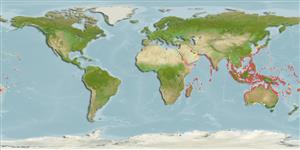Environment: milieu / climate zone / depth range / distribution range
Ecologie
marien; brak water rifbewoner; standvastig; diepte 0 - 6 m (Ref. 86942). Subtropical; 35°N - 36°S, 18°E - 159°W
Indo-West Pacific: Red Sea and East Africa to Samoa, north to the Ryukyu Islands, south to northern Australia and New Caledonia. Migrated to the eastern part of the Mediterranean Sea via the Suez Canal.
Lengte bij maturiteit / Grootte / Gewicht / Leeftijd
Maturity: Lm 23.1, range 18 - ? cm
Max length : 45.0 cm TL mannelijk / geslacht onbekend; (Ref. 30573); common length : 30.0 cm TL mannelijk / geslacht onbekend; (Ref. 5450); max. gerapporteerde leeftijd: 4 Jaren (Ref. 126539)
Dorsale stekels (totaal) : 0; Dorsale zachte stralen (totaal) : 12 - 15; Anale stekels: 0; Anale zachte stralen: 10 - 12. Greatly prolonged, beak-like lower jaw; upper jaw short, triangular and without scales; preorbital ridge absent; total number of gill rakers on first gill arch 25-36; pectoral fins short, not reaching past nasal pit when folded forward; with 3-9 (usually 4-6) vertical bars on the sides. (Ref. 9843). Color bluish dorsally, silvery on sides. 36-41 predorsal scales. Lower lobe of caudal fin longer than upper lobe. Dorsal and anal fins located posteriorly.
Occur in coastal waters of high islands and continental shorelines; generally in areas rich in vegetation (Ref. 5213) and sand flats (Ref. 48635). Form schools. Adults feed mainly on seagrasses, to a lesser extent on green algae and diatoms (Ref. 9843). Breed in estuaries (Ref. 4164). Marketed fresh and dried salted (Ref. 5284, 9843); meat tasty (Ref. 637). Also caught with dragnets (Ref. 30573) and dipnets.
Collette, B.B. and J. Su, 1986. The halfbeaks (Pisces, Beloniformes, Hemiramphidae) of the Far East. Proc. Acad. Nat. Sci. Philadelphia 138(1):250-301. (Ref. 10943)
Status op de Rode Lijst van het IUCN (Ref. 130435)
Gevaar voor de mens
Harmless
Gebruik door de mens
Visserij: commercieel; sportvis: ja; aas: occasionally
Tools
Speciale rapporten
Download XML
Internetbronnen
Estimates based on models
Preferred temperature (Ref.
123201): 24.7 - 29.3, mean 28.5 °C (based on 3383 cells).
Fylogenetische diversiteitsindex (Ref.
82804): PD
50 = 0.5005 [Uniqueness, from 0.5 = low to 2.0 = high].
Bayesian length-weight: a=0.00380 (0.00291 - 0.00496), b=3.07 (3.01 - 3.13), in cm total length, based on LWR estimates for this species (Ref.
93245).
Trofisch niveau (Ref.
69278): 2.7 ±0.30 se; based on food items.
Weerstandsvermogen (Ref.
120179): Hoog, minimale populatieverdubbelingstijd minder dan 15 maanden (Preliminary K or Fecundity.).
Fishing Vulnerability (Ref.
59153): Low to moderate vulnerability (35 of 100).
Nutrients (Ref.
124155): Calcium = 61.2 [21.4, 168.3] mg/100g; Iron = 0.643 [0.265, 1.468] mg/100g; Protein = 18.8 [16.1, 21.2] %; Omega3 = 0.165 [0.067, 0.461] g/100g; Selenium = 12.5 [4.9, 32.5] μg/100g; VitaminA = 39.7 [9.5, 186.7] μg/100g; Zinc = 1.06 [0.61, 1.80] mg/100g (wet weight); based on
nutrient studies.
